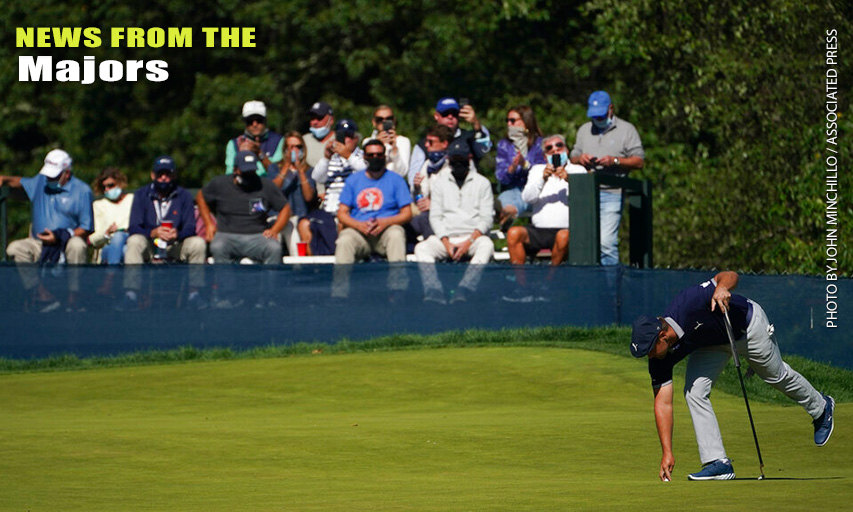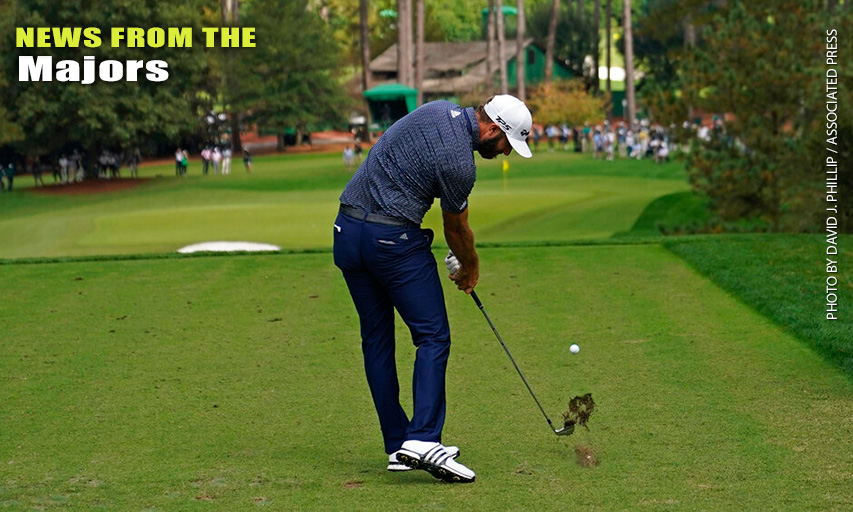Major Shots, And Shots Special To Major Champions
- Details
- Category: Inside Golf
- Published: 2021-01-06

By DOUG FERGUSON, Associated Press
KAPALUA, Hawaii — Dustin Johnson and Bryson DeChambeau are renowned for their power, so in a year no one could have imagined, perhaps it was only fitting the signature shot from their major championships came from shorter clubs.
And then there's Collin Morikawa, polished and precise, who won his major with the longest club in the bag.
Although the British Open was canceled because of the COVID-19 pandemic, it was the first time since 1981 all the majors were decided by two shots or more. That didn't mean they were devoid of crucial moments. Before moving on to a new year, here's a look back at the defining shot of each major, and the shots that were meaningful to the winners even if they didn't get much attention.
PGA CHAMPIONSHIP
Morikawa's driver on the 16th hole of the final round at Harding Park was not only the defining moment of the PGA Championship, it took its place as among the most clutch drives in any major.
He was tied for the lead with Paul Casey, who had just birdied the 16th in the group ahead to reach 11-under par. Morikawa reached for driver on the 294-yard hole with trees down the left and a steep bank leading to Lake Merced on the right.
“I made sure I gave it full thought — what I had to do, where I wanted to miss,” he said. “The wind was from the left and into us. It was a perfect driver. I didn't have to do anything with it. When I hit it, I was just hoping for a straight bounce. And I got the straight bounce.”
The ball settled 7 feet away, and he made the eagle putt to lead by two, his winning margin.
Morikawa mentioned two putts from about 25 feet he felt were equally instrumental that are easy to overlook because they came much earlier in the final round. One was on the first hole, which kept him from losing ground early. The other was on No. 6, where Morikawa pulled his tee shot, put his approach in the right rough and hit a chip 25 feet by the hole.
“I was trying to get out of there with a bogey,” he said. “Those two par putts were huge.”
U.S. OPEN
DeChambeau had a one-shot lead over Matthew Wolff playing the par-5 ninth in the final round at Winged Foot when he tugged a 9-iron that settled some 30 feet left of the flag, which looked even longer when Wolff hit wedge to 10 feet.
“It was a weird putt that I didn't really know how to read it other than to look at it and say, ‘OK, I think this is the right line,’” DeChambeau said. “I was able to start it 27 inches out to the right. It broke farther than that, then it came back. I was just trying to get it close to the hole.”
It dropped for eagle, and he kept his one-shot lead when Wolff made his much shorter eagle putt.

Bryson DeChambeau Picks Up His Ball After Sinking A Putt On The Third Green During The Third Round Of The 2020 U.S. Open. DeChambeau Said This Par Putt Was Key In His Weekend Run Toward His First Major.
DeChambeau says he often has trouble remembering shots at big events because he works so hard at staying in the moment. But he remembers the par-3 third hole on Saturday, which he felt was key to having a chance on Sunday.
Starting the third round one shot behind, DeChambeau opened with two straight bogeys. On the 243-yard third hole, he was left of the bunker that was left of the green. He was staring at a third straight bogey.
“I had to flop it over the bunker,” he said. “It was a very difficult shot, and I hit it up there to 6 feet. That kept me from going 3 over. It saved me a little bit, and I just corrected myself after that. What's interesting is I don't remember much because I'm so focused when I'm in the middle of it. I remember that shot because I was going in the wrong direction.”
THE MASTERS
Johnson swears he wasn't worried.
Starting the final round with a four-shot lead, he had to scramble for par on the easiest hole at Augusta National (the par-5 second), then missed 5-foot par putts on the fourth and fifth holes as his lead shrunk to a single shot.
“I know I made two bogeys, but it wasn't like I made really bad bogeys,” he said. “It didn't bother me. I knew I was swinging it well. I just needed to be patient.”
Patience was rewarded on the next hole, an 8-iron to 6 feet for birdie on the par-3 sixth that built his lead to three shots when Sungjae Im missed a 5-footer for par.
"I just had to judge the distance right,” Johnson said. “I hit a good shot and made a really good putt. That gave me confidence I needed for the rest of the day. That was a really big hole.”

Dustin Johnson Tees Off On The Sixth Hole During The Final Round Of The 2020 Masters. He Made Birdie That Was The Pivotal Shot In His Masters Title.
But it was another 8-iron that Johnson remembers even more fondly.
With a splotch of mud on the right side of his ball in the 10th fairway, he said he aimed right of the bunker toward the azalea bushes expecting the shot to turn to the left, which it did, leaving him a two-putt par. Mud was on the left side of his ball in the 11th fairway, so aim to the left?
“I can't start this in the water,” Johnson said. Instead, he made sure it stayed short of the bunker right of the green, and he got that up-and-down for par.
Those were two great shots, both with 5-iron, both with mud on the ball. But what meant the most to him was an 8-iron to the green on the par-3 12th, the hole that has cost so many contenders over the years.
“As you can see on Sunday, a lot of guys mess that hole up,” Johnson said. “It was into the wind, which is the hardest to play. I had 150 yards to cover the bunker. So I hit a flighted 8-iron, kept it under the trees. It was on the green. I could breathe a little bit.”



